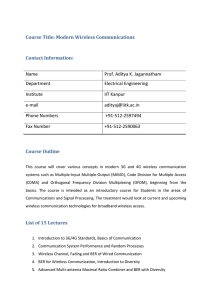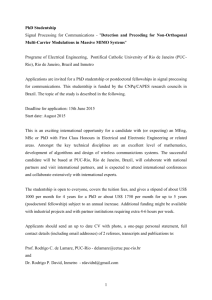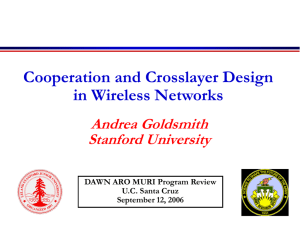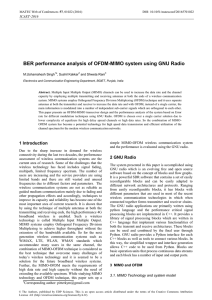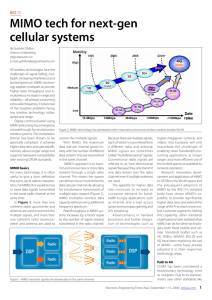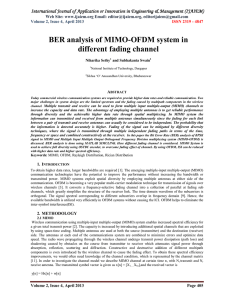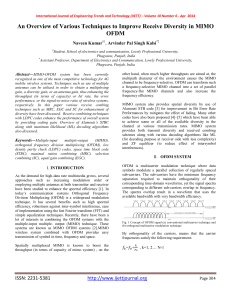Graduate Program in Transportation Engineering
advertisement
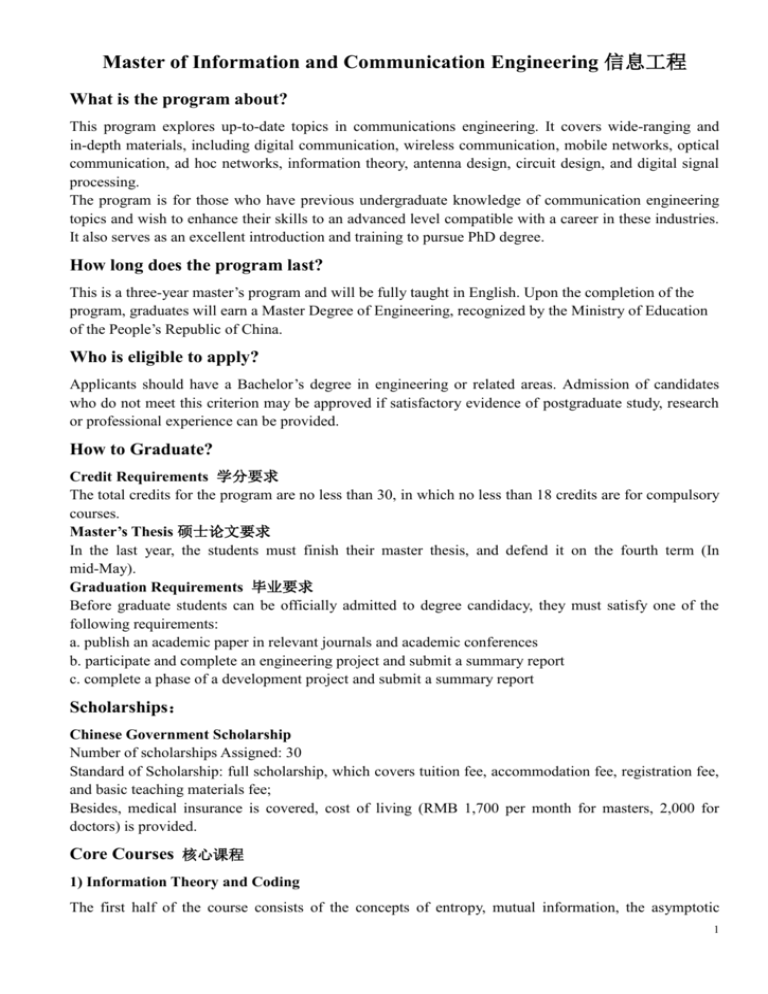
Master of Information and Communication Engineering 信息工程 What is the program about? This program explores up-to-date topics in communications engineering. It covers wide-ranging and in-depth materials, including digital communication, wireless communication, mobile networks, optical communication, ad hoc networks, information theory, antenna design, circuit design, and digital signal processing. The program is for those who have previous undergraduate knowledge of communication engineering topics and wish to enhance their skills to an advanced level compatible with a career in these industries. It also serves as an excellent introduction and training to pursue PhD degree. How long does the program last? This is a three-year master’s program and will be fully taught in English. Upon the completion of the program, graduates will earn a Master Degree of Engineering, recognized by the Ministry of Education of the People’s Republic of China. Who is eligible to apply? Applicants should have a Bachelor’s degree in engineering or related areas. Admission of candidates who do not meet this criterion may be approved if satisfactory evidence of postgraduate study, research or professional experience can be provided. How to Graduate? Credit Requirements 学分要求 The total credits for the program are no less than 30, in which no less than 18 credits are for compulsory courses. Master’s Thesis 硕士论文要求 In the last year, the students must finish their master thesis, and defend it on the fourth term (In mid-May). Graduation Requirements 毕业要求 Before graduate students can be officially admitted to degree candidacy, they must satisfy one of the following requirements: a. publish an academic paper in relevant journals and academic conferences b. participate and complete an engineering project and submit a summary report c. complete a phase of a development project and submit a summary report Scholarships: Chinese Government Scholarship Number of scholarships Assigned: 30 Standard of Scholarship: full scholarship, which covers tuition fee, accommodation fee, registration fee, and basic teaching materials fee; Besides, medical insurance is covered, cost of living (RMB 1,700 per month for masters, 2,000 for doctors) is provided. Core Courses 核心课程 1) Information Theory and Coding The first half of the course consists of the concepts of entropy, mutual information, the asymptotic 1 equipartition property, applications to source coding (data compression), applications to channel capacity (channel coding), differential entropy and its application to waveform channel capacities, and a subset of advanced topics such as network information theory, or rate-distortion theory, as time permits. The second half of the course comprises finite-field algebra, hamming codes, cyclic codes (CRC and BCH codes), a brief introduction to Reed-Solomon codes, and perhaps universal codes (Lempel-Ziv coding). 2) Stochastic Processes This course is an introduction to the theory of continuous-time stochastic processes. We intend to give an overview of two important classes of processes with some classical and fundamental analysis. These processes are so-called martingales and Markov processes. The main part of the course is devoted to developing fundamental results in martingale theory and Markov processes theory, with an emphasis on the interplay between the two worlds. The general results will be used to study fascinating properties of Brownian motion, an important process that is both a martingale and a Markov process. We also plan to study applications like birth-death processes, which is a basic model in queuing theory.. We can study other special classes of Markov processes. For instance, Brownian motion is higher dimensions, diffusions, counting processes. 3) Digital Image Processing This course is a graduate-level introductory course to the fundamentals of digital image processing. It emphasizes general principles of image processing, rather than specific applications. We expect to cover topics such as image sampling and quantization, color, point operations, segmentation, morphological image processing, linear image filtering and correlation, image transforms, eigeimages, multiresolution image processing, wavelets, noise reduction and restoration, feature extraction and recognition tasks, and image registration. For this study, lectures will be complemented by computer exercises where students can develop their own image processing algorithms. For the term project, students will have the option to design and implement the image processing algorithms on hardware device or platform. 4) Array Signal Processing This course introduces the mathematical principles of array signal processing and their applications. The main contents include: Conventional beamformer design, optimum array processing structures, detection and direction of arrival estimation, modern subspace methods; adaptive array algorithms, implementation issues (matrix processing, subspace tracking, array calibration, selected applications from wireless communications, audio processing, underwater acoustics etc. Optional Courses 选修课程 1) Mobile Fading Channel and Error-Correcting System This course will discuss the theoretical aspects of codes and will focus mostly on the worst case noise model pioneered by Hamming. However, we will discuss quite a few results on the stochastic noise model pioneered by Shannon. In this course, the classical theory of Shannon and Hamming will be introduced and then the areas of coding theory will be studied in detail. The course will be roughly divided into three parts. The first part will look at the combinatorial issues in the design of codes. This part will mostly be classical results that talk about limits to what can and cannot be done using codes. 2 The second part of the course will deal with the algorithmic aspects of codes. In particular, we will focus on efficient algorithms that recover the original information from corrupted data (called decoding). In this part we will discuss some exciting recent developments that bridge the "divergent" schools of thoughts of Shannon and Hamming. Finally, we will study some application of codes outside of the "traditional" error correcting applications. In particular, we will see how codes can be used to obtain results in theoretical computer science in general and computational complexity in particular. Most of the course will focus on the first two parts and we will spend 2-3 lectures on applications. 2) Optimization Theory and its Applications This course will deal with applications of static and dynamic optimization theory in (a) Human Life Cycle Research, (b) Economic Research, and (c) Biological Research. The aim of this course is to bring together scientists interested in theoretical modeling across disciplines that are concerned with remarkably similar mathematical problems. We hope to spark new projects and collaborations. The course is open to interested PhD students, post-docs and research scientists. Three distinguished guest lecturers, Antoine Bommier, Hippolyte d'Albis, and John McNamara, will teach the three respective aspects of applications. Based on their own work, lecturers will present methods of optimization by means of discussing their papers and by discussing some classic paper(s) of other authors on the matter. 3) Next Generation Wireless Systems and Networks This course will introduce a broad perspective on services, applications, architectures, standards, and impact of emerging wireless networks and the new wireless technologies and applications, such as MIMO, UWB, Cognitive Radio, and Complementary codes etc, which drives the development and deployment of new wireless networks. Next-generation interfaces, resource management schemes, the important wireless communication standards will also be studied in detail. This course will be given with the combination of related research work and the students are encouraged to make the final project/report by themselves as the examination. 4) Space-Time Signal Processing This course considers space-time processing aspects of signal processing, including fast algorithms, numerical computation, adaptive beamforming, direction of arrival estimation, array processing, adaptive algorithms, channel equalization, blind equalization and identification, and space-time coding, modulation, and MIMO communications and signal processing. 5) Wireless Communication Theory and Applications In this course, we will explore how fundamental theories are applied to real-world wireless communication systems with focus on OFDM and MIMO. The first part of the course will cover OFDM. We will begin with fundamentals of OFDM for time-invariant frequency selective channel from channel partitioning to capacity and bit loading techniques. We will then examine flat fading channels in terms of probability of error and capacity and investigate coding techniques to achieve time diversity and capacity. Next we will study how to achieve frequency diversity and capacity with coding and OFDM in a frequency selective fading channel. The next part of the course will cover MIMO. The capacity and diversity gain in SIMO, MISO, and MIMO channels will be examined first. Then we will explore various MIMO transmit schemes as well as receiver architectures. For receiver architectures, we will begin with MIMO hard detectors and then study MIMO soft detectors, which are not often covered in other wireless communications courses but 3 are almost exclusively used in real-world wireless communications systems. We will also dig into MIMO iterative detection and decoding architectures, which can provide the ultimate performance. If possible, the rest of the course will cover 4G LTE/LTE-A cellular systems with emphasis on the management of inter-cell interference. Some of the latest topics of LTE such as eICIC for HetNet and CoMP will also be briefly touched along with possible directions of beyond-4G systems. 6) Artificial Neural Networks This course examines the theoretical fundamentals of neural networks and their applications, explaining how the underlying concepts are drawn from simplified models of the brain. The practical classes illustrate the theory and provide hands-on-experience through the use of simulation tools (Matlab Neural Network toolbox). Upon completion of the course, students will be familiar with the principles behind the suitability, design and implementation of neural network algorithms for solving pattern recognition and prediction tasks. Topics covered: Biological background, Neural models, architectures and learning paradigms, Perceptrons, Linear networks, Multi-layer feedforward networks, Radial-basis function networks, Competitive learning, Self-organizing feature maps, Learning vector quantization networks, Hebbian learning, Recurrent neural networks, General issues: feature selection, dimensionality reduction, error-rate estimation, combining multiple models. Contact Information: International Admission Office Department of International Affairs Email: admission@sdu.edu.cn Tel: +86-(0)531 88364854/88364853 Website: http://en.sdu.edu.cn/ 4

